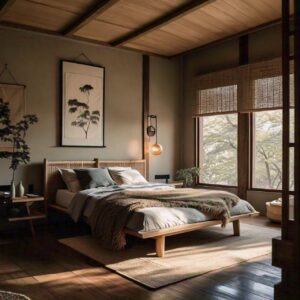Japandi design is more than just a trendy term on Pinterest; it’s a fusion of two timeless styles: Scandinavian and Japanese. Both design philosophies share a deep respect for nature, a focus on simplicity, and an emphasis on creating calm atmospheres. They prioritize form and function over decorative details. Scandinavian and Japanese design have been cherished for more than fifty years. Even if you sometimes roll your eyes at the buzz around “Japandi,” the principles of these two design traditions are here to stay. Their commitment to natural elements, minimalism, and functionality ensures their lasting appeal.
Materials That Define Japandi Style
In Japandi design, natural materials reign supreme, creating a serene and organic atmosphere in the bedroom. Wood, the star of the show, comes in a range of tones, from light ash and oak to rich cherry and walnut. Stone, concrete, cotton, and linen also make appearances, adding depth and texture to the space. To truly embody Japandi style, opt for natural materials in every aspect of your bedroom design. Choose cotton bedding for its breathability and softness, and select a wooden bed frame for its warmth and simplicity. These natural elements seamlessly blend into the signature Japandi neutral color palette, punctuated only by the occasional pop of color from indoor plants or living decor. By embracing nature’s beauty, Japandi design creates a peaceful retreat that promotes relaxation and well-being.
Bringing Japandi Into The Bedroom
Japandi design is a serene and intentional approach to bedroom design, blending the gentle essence of nature with the clean lines of minimalism. This thoughtful style recognizes the bedroom as a sacred space, where the mind and body repair and rejuvenate. By incorporating natural materials, soft textures, and muted colors, Japandi design creates a peaceful atmosphere that calms the senses and nurtures the soul. As we surrender to slumber, this design style whispers sweet dreams, reminding us that our bedroom is a haven for rest, relaxation, and renewal.
1. Designing a Japandi Bedroom with Plywood Doors
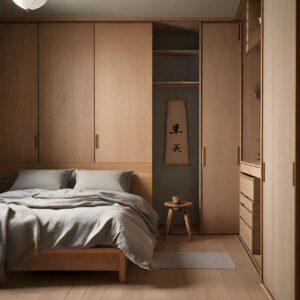 Kirill Bergart’s minimalist bedroom is a testament to the Japandi design philosophy, where simplicity and natural beauty converge. The room’s soft, ethereal light highlights the subtle interplay of textures and tones, from the warmth of the wood accents to the gentle grain of the raw plywood closet doors. A Japanese-style lamp adds a touch of understated elegance, while a wooden stool and neutral bedding bring a cozy, Scandinavian sensibility to the space. The result is a serene and calming atmosphere, perfect for rest and contemplation, that embodies the Japandi ideals of harmony and balance.
Kirill Bergart’s minimalist bedroom is a testament to the Japandi design philosophy, where simplicity and natural beauty converge. The room’s soft, ethereal light highlights the subtle interplay of textures and tones, from the warmth of the wood accents to the gentle grain of the raw plywood closet doors. A Japanese-style lamp adds a touch of understated elegance, while a wooden stool and neutral bedding bring a cozy, Scandinavian sensibility to the space. The result is a serene and calming atmosphere, perfect for rest and contemplation, that embodies the Japandi ideals of harmony and balance.
2. Creating a Warm Japandi Bedroom with Fluted Walls
 This apartment is a peaceful place to relax. The designer, Studio Nishita Kamdar, used natural materials like oak to create a cozy feel. The bed is comfortable and has soft blankets. There’s no headboard, which makes the room feel more open. The result is a calm and quiet space that’s perfect for resting.
This apartment is a peaceful place to relax. The designer, Studio Nishita Kamdar, used natural materials like oak to create a cozy feel. The bed is comfortable and has soft blankets. There’s no headboard, which makes the room feel more open. The result is a calm and quiet space that’s perfect for resting.
3. Japandi Bedroom Design with Limewash Flooring
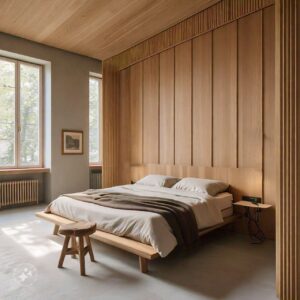 You have a keen eye for detail! Yes, the floors appear to be limewash, which adds a soft, warm texture to the space. The combination of the subtle floor texture, minimalist furniture, and simple wall art creates a serene and sophisticated atmosphere, reminiscent of modern European architecture. The light oak bed frame sets the tone for the space, while the stool and lamp provide functional decor without cluttering the room. The small, framed art piece adds a touch of elegance and restraint, making the space feel artfully curated. Overall, this minimal space is a masterclass in understated design!
You have a keen eye for detail! Yes, the floors appear to be limewash, which adds a soft, warm texture to the space. The combination of the subtle floor texture, minimalist furniture, and simple wall art creates a serene and sophisticated atmosphere, reminiscent of modern European architecture. The light oak bed frame sets the tone for the space, while the stool and lamp provide functional decor without cluttering the room. The small, framed art piece adds a touch of elegance and restraint, making the space feel artfully curated. Overall, this minimal space is a masterclass in understated design!
4. Creating a Modern Japandi Bedroom with Oak Wood Slats
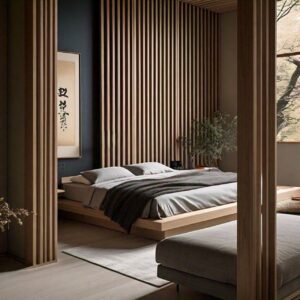 Vertical wood slats have been a part of Japanese design for centuries, and their recent popularity is a testament to their timeless appeal. In a nod to this traditional element, Studio Ninety Design incorporates vertical wood slats into a serene bedroom design.
Vertical wood slats have been a part of Japanese design for centuries, and their recent popularity is a testament to their timeless appeal. In a nod to this traditional element, Studio Ninety Design incorporates vertical wood slats into a serene bedroom design.
The room’s neutral color palette provides a calm backdrop for the striking vertical wood slat wall behind the bed. White oak plank flooring adds warmth and texture, complementing the natural beauty of the wood slats. The result is a peaceful atmosphere that balances traditional Japanese elegance with modern simplicity.
This design doesn’t rely on bold statements or bright colors; instead, it lets the natural beauty of the materials shine. The vertical wood slats create a sense of depth and visual interest, while the neutral colors and natural materials bring a sense of calmness. The result is a bedroom that feels both serene and thoughtfully designed.
5. Creating a Japandi Bedroom with a Wood Slat Divider
 Room dividers have regained popularity, and curved wood slat dividers perfectly capture the essence of Japandi style. They serve both practical and aesthetic purposes, separating spaces while introducing intriguing texture and clean lines. These dividers can define areas within a room, creating cozy nooks or distinct zones. Their curved shape and natural wood material add warmth and visual appeal, making them a great addition to any space. With their versatility and understated elegance, it’s no wonder they’ve become a staple in modern interior design.
Room dividers have regained popularity, and curved wood slat dividers perfectly capture the essence of Japandi style. They serve both practical and aesthetic purposes, separating spaces while introducing intriguing texture and clean lines. These dividers can define areas within a room, creating cozy nooks or distinct zones. Their curved shape and natural wood material add warmth and visual appeal, making them a great addition to any space. With their versatility and understated elegance, it’s no wonder they’ve become a staple in modern interior design.
6. Creating a Moody Japanese Zen Bedroom
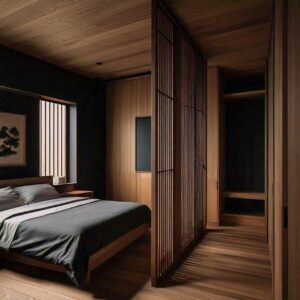 This bedroom design takes a darker, moodier approach, diverging from the airy feel of previous spaces. The emphasis on natural wood surfaces is key. The vertical wood slat room divider and hardwood panelling on the right side of the frame create a cohesive look. These elements, paired with the minimalist nature of the space, draw heavily from Japanese Zen design, a core influence on Japandi style. The result is a tranquil, contemplative atmosphere, perfect for a bedroom retreat. The wood surfaces add warmth, while the minimalism maintains a sense of calm, creating a harmonious balance.
This bedroom design takes a darker, moodier approach, diverging from the airy feel of previous spaces. The emphasis on natural wood surfaces is key. The vertical wood slat room divider and hardwood panelling on the right side of the frame create a cohesive look. These elements, paired with the minimalist nature of the space, draw heavily from Japanese Zen design, a core influence on Japandi style. The result is a tranquil, contemplative atmosphere, perfect for a bedroom retreat. The wood surfaces add warmth, while the minimalism maintains a sense of calm, creating a harmonious balance.
7. Creating a Warm Scandinavian Bedroom with Wood Slat Wall
 This Scandinavian bedroom exudes understated elegance, thanks to the vertical wood slat wall that adds a nuanced texture for light to dance across. The simple design is elevated by warm sconce lighting, transforming the space into a snug retreat. The result is a cozy haven that invites relaxation, making it the perfect sanctuary to unwind and escape the world outside. The subtle interplay of light, texture, and warmth creates a sense of comfort and tranquility, making this bedroom a true haven.
This Scandinavian bedroom exudes understated elegance, thanks to the vertical wood slat wall that adds a nuanced texture for light to dance across. The simple design is elevated by warm sconce lighting, transforming the space into a snug retreat. The result is a cozy haven that invites relaxation, making it the perfect sanctuary to unwind and escape the world outside. The subtle interplay of light, texture, and warmth creates a sense of comfort and tranquility, making this bedroom a true haven.
8. Designing a Japan-Inspired Country Bedroom
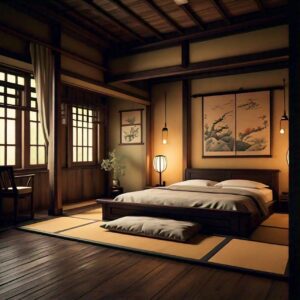 J Balvin’s serene bedroom retreat embodies his philosophy that a home should nourish the spirit, not the ego. This Zen-inspired sanctuary is a masterclass in understated elegance, with white oak veneered wall panels evoking a sense of natural tranquility. The subtle horizontal wood slats above the window filter the light, infusing the space with a soft, ethereal glow while paying homage to Japanese design. The result is a harmonious balance of nature, light, and texture, creating a haven that soothes the soul. This bedroom is a testament to the power of thoughtful design in crafting a space that truly feeds the spirit.
J Balvin’s serene bedroom retreat embodies his philosophy that a home should nourish the spirit, not the ego. This Zen-inspired sanctuary is a masterclass in understated elegance, with white oak veneered wall panels evoking a sense of natural tranquility. The subtle horizontal wood slats above the window filter the light, infusing the space with a soft, ethereal glow while paying homage to Japanese design. The result is a harmonious balance of nature, light, and texture, creating a haven that soothes the soul. This bedroom is a testament to the power of thoughtful design in crafting a space that truly feeds the spirit.
9. Grounded Style for Boutique Hotel Bedrooms
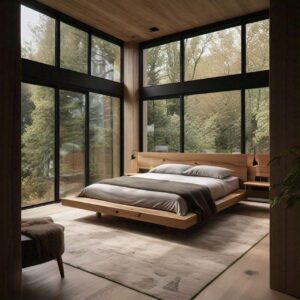 The understated elegance of the solid wood bed frame provides a serene backdrop for this tranquil retreat. Its minimal profile allows the showstopping floor-to-ceiling window to take center stage, flooding the space with natural light and framing the outdoors. Meanwhile, thoughtful decor choices add a touch of warmth and personality to the room, striking a perfect balance between simplicity and sophistication. The result is a peaceful haven that exudes calmness and serenity, inviting relaxation and contemplation.
The understated elegance of the solid wood bed frame provides a serene backdrop for this tranquil retreat. Its minimal profile allows the showstopping floor-to-ceiling window to take center stage, flooding the space with natural light and framing the outdoors. Meanwhile, thoughtful decor choices add a touch of warmth and personality to the room, striking a perfect balance between simplicity and sophistication. The result is a peaceful haven that exudes calmness and serenity, inviting relaxation and contemplation.
10. Designing a Light and Airy Scandinavian Bedroom
 This harmonious blend of natural wood, metal accents, indoor greenery, and linen bedding creates a refreshing sanctuary that effortlessly balances youthful energy with mature sophistication. Perfect for lazy Sunday mornings, this inviting space showcases a unique fusion of Scandinavian simplicity and Japanese elegance, courtesy of the horizontal wood slats. The result is a calming Japandi-inspired retreat that exudes warmth, serenity, and effortless style, making it an ideal haven for relaxation and rejuvenation.
This harmonious blend of natural wood, metal accents, indoor greenery, and linen bedding creates a refreshing sanctuary that effortlessly balances youthful energy with mature sophistication. Perfect for lazy Sunday mornings, this inviting space showcases a unique fusion of Scandinavian simplicity and Japanese elegance, courtesy of the horizontal wood slats. The result is a calming Japandi-inspired retreat that exudes warmth, serenity, and effortless style, making it an ideal haven for relaxation and rejuvenation.
Conclusion
Japandi design seamlessly merges Scandinavian and Japanese aesthetics to create tranquil, minimalist spaces that emphasize natural beauty and functionality. By utilizing natural materials like wood, stone, and linen, and incorporating subtle elements such as wooden slats, plywood doors, and organic textures, Japandi design offers a timeless appeal that transcends trends. Each design choice, from cozy wood slat dividers to moodier Zen-inspired settings, reflects a deep respect for simplicity and calm. Whether through the warmth of oak, the elegance of neutral tones, or the thoughtful placement of decor, Japandi bedrooms create serene havens that foster relaxation and rejuvenation. This approach to design celebrates the enduring principles of minimalism and nature, ensuring that these spaces remain relevant and soothing for years to come.
About the Author

-
Welcome to A HomedesignMag! I'm Nancy, a content writer and blog post creator. I share my experience with different homedesign tools and techniques on the blog!
contact us at:
Latest entries
 UncategorizedOctober 15, 2024Timeless Beauty of Mahogany
UncategorizedOctober 15, 2024Timeless Beauty of Mahogany OutdoorsOctober 13, 2024Patio Perfection: 9 Awe-Inspiring Roof Extension Ideas to Add Charm
OutdoorsOctober 13, 2024Patio Perfection: 9 Awe-Inspiring Roof Extension Ideas to Add Charm WindowsAugust 13, 2024Elevating Interiors with Kirsch Sliding Door Blinds
WindowsAugust 13, 2024Elevating Interiors with Kirsch Sliding Door Blinds BathroomAugust 11, 2024Designing Showers with Mosaic Tiles
BathroomAugust 11, 2024Designing Showers with Mosaic Tiles

